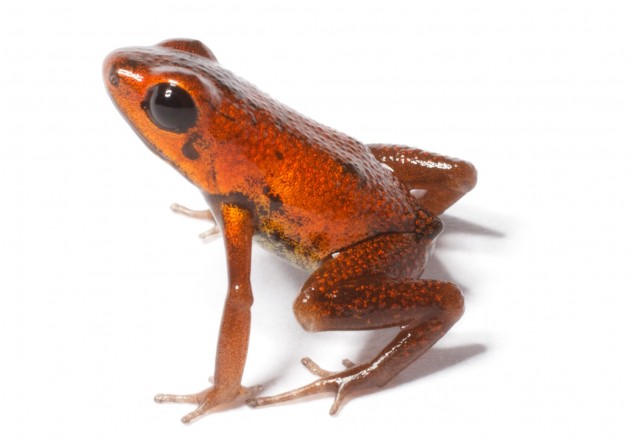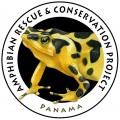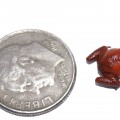By John Barrat
Bright orange with a distinctive call the Panamanian poison dart frog Andinobates geminisae lives in only a small area of the Caribbean Coast of Panama. It was discovered and named just a few months ago yet scientists already fear for its future from habitat loss, pet-trade collectors and chytrid fungus—a deadly disease that is decimating frog populations across the globe.

“Andinobates geminisae” (Photo: Brian Gratwicke)
At the Smithsonian’s National Zoo Brian Gratwicke leads the Panama Amphibian Rescue and Conservation Project, a modern-day Noah’s Ark that is attempting to save endangered frog species from chytrid by raising and breeding captive populations. Gratwicke answers a few questions about the Amphibian Rescue Project and if A. geminisae might become its newest member.
Q: How do you decide to add a new species to the Amphibian Ark?
Gratwicke: We have about 12 different species now in the Amphibian Rescue and Conservation Project and our goal is to grow that to about 20. To add a new species like A. geminisae we’d need to collect at least 10 males and 10 females to be represented in its first captive generation. For species that are difficult to breed we might need to collect more animals than that to ensure that we can maintain a genetically healthy captive population.
So that’s one big unknown; A. geminisae is a fairly rare frog and we don’t know if we will be able to find more. Maybe they have already declined from chytrid, which can happen rapidly. We’ve run into a situation before where we found three frogs of a species that is highly sensitive to chytridiomycosis on our first trip, and after going back numerous times, never saw any ever again.

Limosa harlequin frogs are among the 12 frog species currently in the Amphibian Rescue Project. (Photo by Brian Gratwicke)
But before we add a species to the Amphibian Rescue Project and devote the resources and staff necessary to care for it, we also need to be in a position to make a really informed decision about adding it. So, we first try to make as many natural history observations about a potential candidate as we can. With A. geminisae we are not sure what its susceptibility is to chytrid. It seems to be a fairly terrestrial frog [chytrid is a water-borne fungus] and we are not even sure if chytrid will kill them.
We also need to figure out what environmental cues a frog needs to reproduce, where it reproduces and what habitat might be limiting for reproduction. For some species we may also turn to people who keep similar species as pets to learn about successful husbandry practices and what they have done to rear them successfully. There are a fair number of Andinobates in the pet trade because they are really attractive little frogs.
So, right now our real priority is to learn a little more about this species and whether we can breed it in captivity.
Q. Are pet-trade collectors a problem for frogs?
Gratwicke: Because of its color A. geminisae might be attractive animal to collectors. Once people know where it is some will certainly go looking for it. Panama has few collectors but they could have an impact when they harvest frogs from a very small population. For example, Panamanian golden frogs were once found in Cerro Campana National Park in Panama, but they were totally collected out of that locality, even before chytrid became an issue.

Brian Gratwicke swabs a frog in the field to test it for the deadly chytrid fungus. (Photo courtesy Brian Gratwicke)
Q. If chytrid is here to stay, what is the ultimate plan for the frogs in the ark?
Gratwicke: The ultimate plan for our existing collection is to develop some tools that we might use to help these frogs resist chytrid infection, and then reintroduce frogs that are less susceptible to the disease back into the wild. We’ve been actively researching the frog’s skin microbiome, with the hope that we could treat susceptible frogs with beneficial skin bacteria that might protect them from fungal infections, but it has proven much more difficult to manipulate the frog skin microbiome than we anticipated.
We also have been looking at the immune response of frogs to chytrid fungus and we’ve found that some frogs have very strong immune response as measured through their transcriptomes. Basically each cell has a nucleus full of DNA that is converted to RNA before making the proteins that govern cell function. So when we do a transcriptome analysis we are reading the RNA that is actually giving orders to all of the organelles to make various different kinds of proteins and ultimately get a glimpse of the genes being expressed at a single moment in time in any particular tissue.
So let’s say we actually find a frog that manages to resist a chytrid infection. We’d look to see if this group has a different genetic signature than the non-chytrid resistant group. Our ultimate aim would be to understand the frog’s immune response to chytrid infection so that we could help give them a leg up in the battle against chytrid.

“Atelopus certus,” lives Cerro Sapo (or Toad Mountain) in the Darien Region of eastern Panama, and is one of the most strikingly colored or all harlequin frogs. This species is in the Amphibian Rescue Project. (Photo by Brian Gratwicke)
Q. How long do these frogs live and are they breeding well?
Gratwicke: A frog’s lifespan depends on the species. Some species like the La Loma tree frog seems to be really short lived. The oldest frog of this species we’ve had in captivity has lived about 5 years, but on the other hand Panamanian golden frogs can live for more than 15 years!
All the frogs in our Amphibian Rescue Project pods are wild-collected founding members or their first generation offspring. Our goal is to breed all of the founders as quickly as possible. We don’t want to begin breeding a second generation until we have as many of the founders bred as we can. This way we capture as much of the genetic diversity of our founders before those animals die. If they die without being bred, they’re gone forever, so we are really racing against the clock.
Q: Are there things you can do to get captive frogs in the mood to mate?
Gratwicke: Yes, there are a lot of different potential cues to get a frog, male and female, into breeding condition. For certain species we’ve tried making it rain, we tried a simulating misting system, we tried making waterfalls, we played calls back to them at night, we tried giving them a little bit of light, we tried giving them no light, we tried giving them all different kinds of food.
Nutrition is important; you’ve got to have an animal in a really positive nutritional space before they can expend energy on reproduction. For our harlequin frogs, we breed them a special kind of moth larva that has a high fat content and we give them to the females to get them to start producing eggs.
Q: What other measures are being taken to save these frogs?
Gratwicke: We’re also doing some research to see if we can freeze frog sperm and we have pretty good results coming out of that program right now. So hopefully we could actually freeze frog sperm of all of our male founders that are not yet represented in captivity, so that if they do die before they are actually breed we can still have a plan B. Frozen sperm is kind of an insurance policy. Researchers have been trying to do this for many years and have largely failed, because frog sperm is activated in a frog’s urine and once activated it is really hard to cryopreserve, and then thaw.





